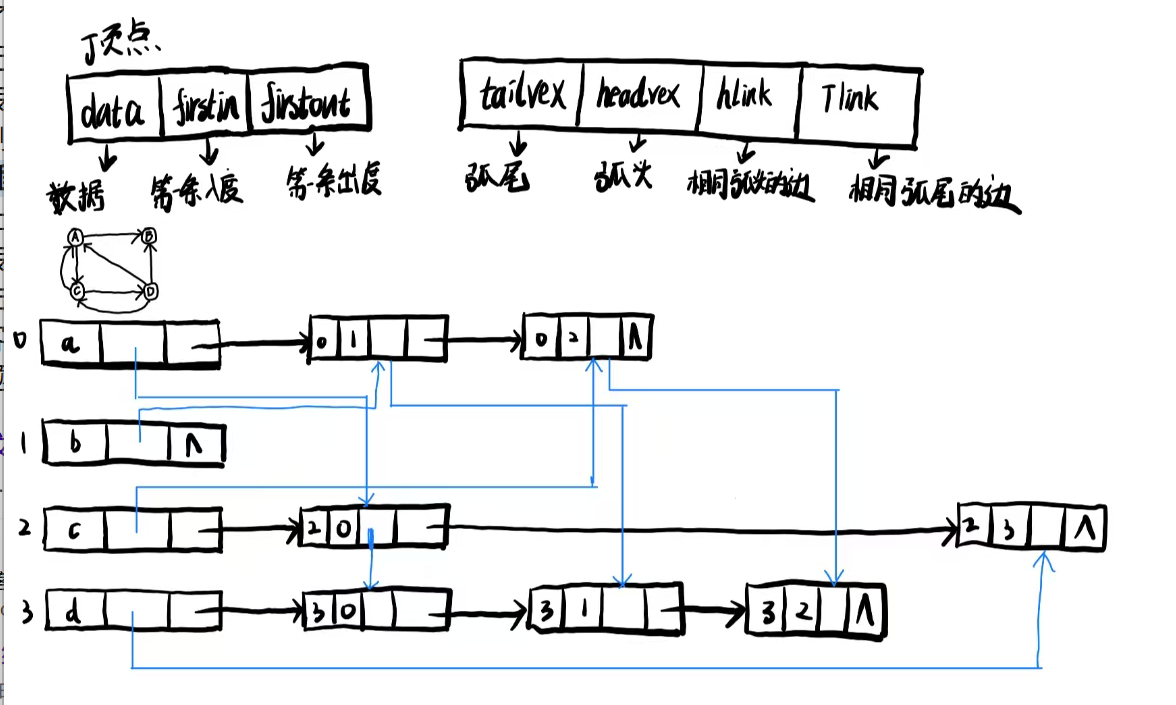十字链表的构建和操作
前面两期给大家讲解了两种关于构建图的算法,分别是邻接矩阵和邻接表,但这两种算法分别都有各自的缺陷,比如说邻接矩阵的空间复杂度太大,邻接表寻找有向图的入度极其困难,今天给大家介绍一中存储有向图比邻接表更加优秀的算法-----十字链表法
邻接表的缺陷无非就是寻找入度的时候时间复杂度较大,我们可以在创建结构体的时候在里面入度的成员,这样访问的时候就会非常便捷。

这个图里面分别有两个结构体
第一个是顶点的,里面存储了数组域和第一条入度和第一条出度,这样我们在寻找的时候只需要找到第一个然后依次寻找即可
第二个是边的结构体,里面存储是数组元素的下标其实就是弧头和弧尾指向的顶点,另外两个是下一个弧头和下一个弧尾
具体代码:
//十字链表法
#include<stdio.h>
#include<stdbool.h>
#include<stdlib.h>
#define MAX 4//假设有四个元素
//边的结构体
typedef struct Edge
{
int tailvex, headvex;//弧头和弧尾编号
struct Edge* HLinkNext;//相同弧头的下一条弧
struct Edge* TLinkNext;//相同弧尾的下一条弧
}Edge;
//顶点结构体
typedef struct Vertex
{
char data;//数据域
struct Edge* firstin, * firstout;//第一条入度弧和第一条出度弧
}Vertex;
//定义图
typedef struct Graph
{
Vertex arr[MAX];//数组元素的数组
int num;//顶点数量
}Graph;
//初始化
void InitGraph(Graph * G)
{
G->num = 0;
int i;
for (i = 0; i < MAX; i++)
{
//还未添加顶点
G->arr[i].data = '\0';
G->arr[i].firstin = NULL;
G->arr[i].firstout = NULL;
}
return;
}
//添加顶点
bool EnGraph(Graph* G)
{
if (G->num > MAX)
return false;//元素个数大于数组长度
int i;
for (i = 0; i < MAX; i++)
G->arr[i].data = 'A' + i;//给数组赋值
G->num = MAX;
return true;
}
//添加边
bool EnEdge(Graph* G,int from,int to)
{
if (G->num > 4 || G->num < 0)
return false;//数据不合法
//创建A -> B
Edge* e = (Edge*)malloc(sizeof(Edge));
if (e == NULL)
return false;//分配空间失败
//赋值
e->headvex = from;
e->tailvex = to;
//为顶点建立连接
//建立出度连接(头插法)
e->TLinkNext = G->arr[from].firstout;
G->arr[from].firstout = e;
//建立入度连接(头插法)
e->HLinkNext = G->arr[to].firstin;
G->arr[to].firstin = e;
return true;
}
//查到顶点的出度和入度
bool FindDegree(Graph * G,char ch)
{
if (G->num == 0)
return false;//非图
int index = -1;
//查找ch是否存在
for (int i = 0; i < MAX; i++)
{
if (G->arr[i].data == ch)
{
index = i;
break;
}
}
if (index == -1)
return false;//不存在该顶点
Edge * DegreeIn = G->arr[index].firstin;
Edge* DegreeOut = G->arr[index].firstout;
//求入度
while (DegreeIn != NULL)
{
printf("%c的入度为%c\n", ch, G->arr[DegreeIn->headvex].data);
DegreeIn = DegreeIn->HLinkNext;
}
//求出度
while (DegreeOut != NULL)
{
printf("%c的出度为%c\n", ch, G->arr[DegreeOut->tailvex].data);
DegreeOut = DegreeOut->TLinkNext;
}
return true;
}
int main()
{
Graph G;//定义图
InitGraph(&G);//初始化图
EnGraph(&G);//添加顶点
//添加边
//A->B A->C
EnEdge(&G, 0, 1);
EnEdge(&G, 0, 2);
//C->A C->D
EnEdge(&G, 2, 0);
EnEdge(&G, 2, 3);
//D->A D->B D->C
EnEdge(&G, 3, 0);
EnEdge(&G, 3, 1);
EnEdge(&G, 3, 2);
//查找顶点的出度和入度
FindDegree(&G, 'A');
return 0;
}
时间复杂度:O(|V| + |E|)顶点 + 边数
空间复杂度O(n)
